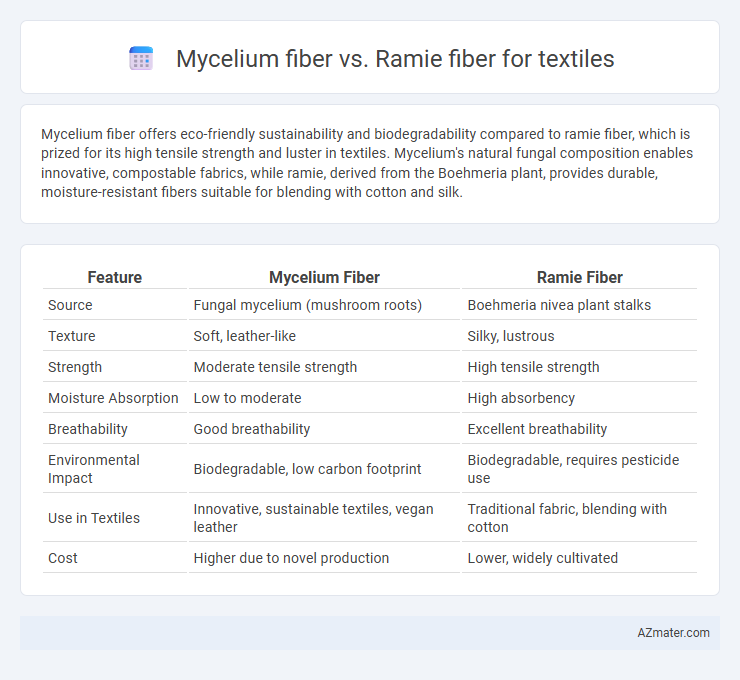Mycelium fiber offers eco-friendly sustainability and biodegradability compared to ramie fiber, which is prized for its high tensile strength and luster in textiles. Mycelium's natural fungal composition enables innovative, compostable fabrics, while ramie, derived from the Boehmeria plant, provides durable, moisture-resistant fibers suitable for blending with cotton and silk.
Table of Comparison
| Feature | Mycelium Fiber | Ramie Fiber |
|---|---|---|
| Source | Fungal mycelium (mushroom roots) | Boehmeria nivea plant stalks |
| Texture | Soft, leather-like | Silky, lustrous |
| Strength | Moderate tensile strength | High tensile strength |
| Moisture Absorption | Low to moderate | High absorbency |
| Breathability | Good breathability | Excellent breathability |
| Environmental Impact | Biodegradable, low carbon footprint | Biodegradable, requires pesticide use |
| Use in Textiles | Innovative, sustainable textiles, vegan leather | Traditional fabric, blending with cotton |
| Cost | Higher due to novel production | Lower, widely cultivated |
Introduction to Mycelium and Ramie Fibers
Mycelium fiber, derived from the root-like structures of fungi, offers a sustainable and biodegradable alternative in textile production due to its natural growth process and low environmental impact. Ramie fiber, extracted from the stalks of the Boehmeria plant, is renowned for its strength, smooth texture, and ability to retain shape, making it a valuable natural fiber in the textile industry. Both fibers present unique ecological benefits, with mycelium providing innovative bio-based material potential and ramie offering traditional plant-based durability.
Origins and Production Processes
Mycelium fiber is derived from the root-like structures of fungi, grown through sustainable mycelial networks cultivated on organic substrates, promoting eco-friendly production with minimal water and pesticide use. Ramie fiber is extracted from the stalks of the Boehmeria nivea plant through processes involving retting, scraping, and degumming to remove gums and impurities, yielding a strong, lustrous fiber used in traditional textile manufacturing. Both fibers differ significantly in their biological origins and production methods, with mycelium representing an innovative fungal-based alternative and ramie being a longstanding bast fiber crop.
Environmental Impact Comparison
Mycelium fiber offers a sustainable alternative to traditional textiles by utilizing fungal biomass that requires minimal water, no pesticides, and emits less carbon compared to Ramie fiber, which relies on intensive cultivation practices often involving substantial water and chemical inputs. Ramie fiber, derived from the stalks of the Boehmeria plant, has biodegradability benefits but its large-scale farming can lead to soil degradation and water pollution due to agrochemical use. The environmental footprint of mycelium fiber is generally lower, promoting circular economy principles through biodegradability and waste valorization in textile production.
Physical Properties and Strength
Mycelium fiber exhibits excellent tensile strength and lightweight properties, making it a sustainable alternative to traditional textile fibers. Ramie fiber is known for its high strength, durability, and resistance to stretching, with a tensile strength comparable to flax and superior moisture absorption. While Ramie offers superior durability for heavy-duty textiles, Mycelium fiber excels in flexibility and biodegradability, ideal for innovative eco-friendly fabrics.
Versatility in Textile Applications
Mycelium fiber offers unique versatility in textile applications due to its biodegradable properties and adaptability for creating sustainable, eco-friendly fabrics with varying textures and strengths. Ramie fiber is prized for its natural luster, durability, and resistance to wrinkling, making it suitable for a wide range of garments and home textiles requiring a blend of strength and aesthetic appeal. Both fibers contribute to innovative textile solutions, with Mycelium excelling in sustainable innovation and Ramie delivering traditional performance and versatility.
Comfort and Wearability
Mycelium fiber offers exceptional breathability and softness, making it highly comfortable for textile applications, while its natural moisture-wicking properties enhance wearability during extended use. Ramie fiber is known for its strong, lustrous texture and excellent durability, but it can feel rougher against the skin compared to mycelium fiber, potentially impacting comfort. Both fibers provide sustainable alternatives, yet mycelium excels in creating lightweight, flexible garments ideal for high-comfort wear.
Biodegradability and Sustainability
Mycelium fiber and ramie fiber both exhibit notable biodegradability, but mycelium fiber, derived from fungal mycelium, decomposes more rapidly due to its organic fungal composition, making it highly sustainable for textile applications. Ramie fiber, a natural bast fiber from the Boehmeria plant, offers durability and biodegradability yet requires significant water and chemical inputs during cultivation and processing, impacting its overall environmental footprint. Mycelium fiber's low resource requirements and ability to grow on waste substrates highlight its superior sustainability profile compared to traditional ramie fiber in eco-friendly textile production.
Cost and Market Availability
Mycelium fiber offers a sustainable alternative to traditional textiles but currently incurs higher production costs due to limited industrial-scale manufacturing, impacting its market availability. Ramie fiber, derived from the stalks of the Boehmeria plant, remains cost-effective and widely accessible, benefiting from established supply chains and mature processing technologies. The textile market favors ramie for its affordability and consistent supply, while mycelium fiber's potential for eco-friendly innovation drives niche demand despite higher prices.
Challenges and Limitations
Mycelium fiber faces challenges such as limited scalability, inconsistent fiber strength, and higher production costs compared to traditional textiles. Ramie fiber's limitations include its brittleness, expensive retting process, and the need for chemical treatment to enhance softness and dye absorption. Both fibers require advancements in processing technology to improve durability, uniformity, and commercial viability for widespread textile applications.
Future Prospects in Sustainable Textiles
Mycelium fiber offers a groundbreaking biodegradable alternative in sustainable textiles, characterized by rapid growth, low resource consumption, and natural antimicrobial properties. Ramie fiber, known for its strength and sheen, presents a renewable plant-based option with established processing techniques and increasing eco-friendly cultivation practices. Future prospects emphasize integrating mycelium's innovative biotech potential with ramie's durability to develop hybrid fabrics that reduce environmental impact and meet evolving consumer demand for sustainability.

Infographic: Mycelium fiber vs Ramie fiber for Textile
 azmater.com
azmater.com